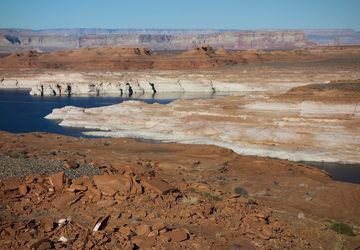Portrait of a Zoom class session: Craig Childs showing his journals to us. (Photo credit: Richard Nevle)
By Samantha Faul B.S. ’18, M.S. ‘20
Hometown: Los Gatos, CA
Major: Earth Systems
This quarter, I am a teaching assistant for Wild Writing, a class that explores and interrogates nature and wilderness through readings, discussion, and creative nonfiction writing. At the end of April, with the support of the Bill Lane Center, we had a guest visit from Craig Childs, a wilderness writer who often focuses on the American West. Below is my reflection on his work, remote learning, and what nature writing does for me during a pandemic.
Our assigned reading from Craig Childs’s large catalog was the essay “Raven,” so it felt right that on the day Childs visited our Wild Writing class via Zoom, a crow came to visit me. Perched on my neighbors’ roof, the crow paused its activity of rooting through the leaf detritus in the gutter to lock eyes with me through my bedroom window. Though crows are distinct from ravens, they share their garb of sleek black feathers and thick, curved beak. They also share a sense of ominousness and up-to-no-good-ism that Childs writes about in his piece through a series of mesmerizing metaphors. His ravens are weighted with the accusatory power of a librarian’s pointing finger, imbued with the sense of mystery of a sorcerer wearing sleek robes. In his stories, Childs explores what ravens and other animals do when we aren’t watching them. I wonder what on earth the crows in my neighborhood are doing. What evil machinations require so much cawing, and at such loud volume?
Childs’s ravens are just as curious about him as he is about them. “Raven” takes place among the rock towers and canyons of the deserts of southeast Utah, in one of the wide expanses of public land that figure so prominently in our imagination of the American West. In the piece, Childs is walking through the desert alone at dawn when a lone raven flying through the sky catches his attention. The raven’s attention is also caught: Obviously, says Childs, the raven wonders what he is and what he is doing there. The bird then flies seemingly directly into the side of a cliff, prompting an intrigued Childs to follow it into a strange raven world: a steep and narrow canyon, its walls lined up and down with ravens guarding the place where they tore an owl to shreds. It’s a fascinatingly odd world, which connects to one of Childs’s purposes as a writer: to show his readers the weird and amazing things that are happening in nature, that we didn’t even know about.
In the opening minutes of our conversation with him, Childs took us out on his deck to see the land around the house where he is self-isolating right now. His head bobbed in the little box framing his video stream, we saw glimpses of bookshelves and his décor, and then he turned the camera to give us a blurry glance at the landscape around him in rural western Colorado. I stared longingly. When I go out onto my parents’ deck at the house I grew up in the south San Francisco Bay Area, I see some lovely redwood and oak trees in my neighbors’ yards, but I also see other suburban homes and I hear the hum of the California 85 freeway. I haven’t been to a park or open lands in over a month, a rarity for someone who got out for at least one hike a week in the opening months of 2020 before the pandemic descended.
"As restlessness builds while I spend more and more time in my new, narrowed world, as I long for the Pacific ocean, the redwood forests, and our aromatic, spiky chaparral, Childs’ words are a needed reminder that the world around me is still beautiful and mysterious."
Sometimes I fall into the trap of thinking of urban and suburban nature as less interesting and exciting than the kind of nature I must travel long distances to reach. I admit, I very much wanted the crow peering through my window to be a raven, which primarily live in open country or forests, instead of the crows so common in agricultural fields and cities. Common equals boring, right? I kind of expected Craig Childs, a man very comfortable wandering through the desert alone, to also think of urban spaces as boring or even distasteful too. I was wrong. He told us that he loves cities and does the same thing there as he does in the desert: following around animals to see what they are doing. New York City is just as much a wilderness to him as the backcountry, just with a different substrate. Instead of rock, there is glass. Instead of boulders, there are people. As restlessness builds while I spend more and more time in my new narrowed world, as I long for the Pacific ocean, the redwood forests, and our aromatic, spiky chaparral, Childs’ words are a needed reminder that the world around me is still beautiful and mysterious.
The world around me is still beautiful and mysterious, even amidst a global pandemic. Though my experience of the pandemic has been marked by losses, there have also been spots of brightness: our class meeting with Childs, facilitated by the Bill Lane Center, and our new familiarity with Zoom. Pictures of the brilliant maroon and yellow spring wildflowers blooming near a student’s house in Texas in our class group chat, and the feeling that we are still a community that supports each other despite the miles between us. Nature stories that transport me to places I have never physically been, to see things I’ve never seen before and feel awe at the beauty and strangeness of our world.



